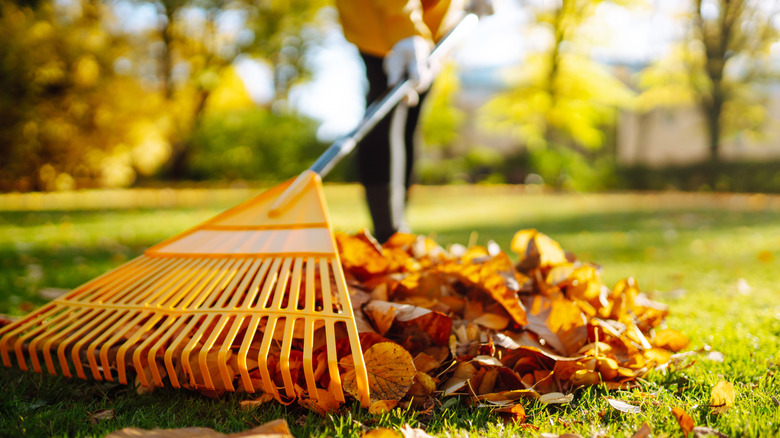You've Been Using The Wrong Rake, And It Shows In Your Garden
At first glance, it may seem like all rakes are created equal. They all feature the same basic design: a long handle, typically made of wood, and a series of plastic, metal, or wooden teeth to drag over the ground. However, subtle differences among the various types of rakes make each style better suited for some landscaping chores than others. If you use a rake meant for removing leaves to spread mulch or break up clumps of soil, you'll likely wind up with visibly uneven garden beds. Similarly, a metal garden rake used on your lawn could result in unsightly bare patches or holes in your carefully maintained grassy patch.
A rake is among the most essential gardening tools, but you'll likely want a few different types in your landscaping arsenal. In general, you want a sturdy rake with rigid tines for heavy-duty digging, leveling, and grading tasks. In contrast, a leaf or lawn rake, which has flexible tines, works best for removing leaves and other light debris, especially from lawn or turf areas. With a selection of different rakes in your garage or shed, you'll likely be prepared for most garden or landscaping jobs, as long as you don't use the wrong rake for the different tasks you need to take care of.
Don't use a steel garden rake to rake leaves on your lawn
A metal garden rake, also known as a bow rake, usually features a long handle and short metal tines evenly spaced along the head. The teeth are curved but rigid and sit at a 90-degree angle from the handle; this configuration enables them to grab onto larger chunks of material, such as soil or mulch. The bottom side is usually flat, which makes these rakes effective for leveling soil. But, while it is sturdy enough to handle heavy-duty gardening tasks, it is a poor choice for raking leaves on your lawn. Because its teeth are sharp, making them effective for grabbing heavier debris, they can tear up your turf and lift chunks of soil and grass without actually gathering up the leaves. As a result, you may wind up with ugly bare spots in your lawn that require reseeding. Or even worse, small holes in your perfectly manicured turf.
On the plus side, this type of rake is the best tool for soil preparation tasks, thanks to its sturdy, rigid teeth.. You can use it to level soil, spread loose material, such as soil, gravel, or mulch, break up compacted or large clumps of dirt, and prepare garden beds for planting. It's also one of the best tools for raking gravel walkways or paths on a slope.
Do not use leaf or lawn rakes for heavy-duty tasks
Leaf rakes and lawn rakes share a similar design, featuring a long, straight handle and a series of long, thin, flexible tines arranged in a fan shape. The tines are slightly curved, too, which helps them scoop up materials as they pass over the ground. The major difference between the two types is that leaf rakes generally have plastic teeth, while lawn rakes usually have teeth made of spring steel. Due to their light build, neither lawn nor leaf rakes should be used to scoop up large rocks or perform heavy tasks like layering and grading. They won't do a good job of these tasks, and the end result will be a visible mess in your yard. Worse yet, they may suffer damage under the strain.
On the other hand, both leaf rakes and lawn rakes are effective for cleaning up fallen leaves and other lightweight debris. They are essential for keeping your lawn in tip-top shape in the fall, but they can come in handy year-round for removing light yard waste, such as grass clippings and pine needles. Their flexible tines ensure that your grass isn't damaged as the rake collects leaves and other materials, too.
Lawn rakes are also suitable for other tasks, thanks to their metal, rather than plastic, tines. They are strong enough to move slightly heavier debris than leaf rakes, so they can clean up wet leaves and evenly spread gravel. A lawn rake can also help dethatch and aerate slightly compacted soil, so water and air can reach plant roots more easily and promote healthy growth.


